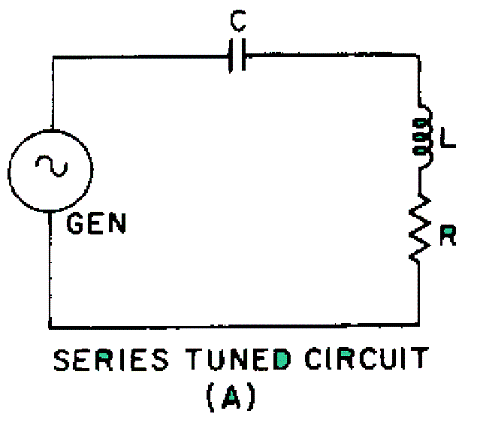Tuned Circuits
Tuned circuits play an integral role when your radio or television set is turned on. Many events take place within the "receiver" before you hear the sound or see the picture being sent by the transmitting station.
Many different signals reach the antenna of a radio receiver at the same time. To select a station, the listener adjusts the tuning dial on the radio receiver until the desired station is heard.
Within the radio or TV receiver, the actual "selecting" of the desired signal and the rejecting of the unwanted signals are accomplished by what are called TUNED CIRCUITS .
A tuned-circuit consists of a coil and a capacitor connected in series or parallel. Whenever the characteristics of inductance and capacitance are found in a tuned-circuit, the phenomenon as RESONANCE takes place.
Inductive reactance (XL) and capacitive reactance (XC) have opposite effects on circuit impedance (Z). If the frequency applied to an LCR circuit causes XL and XC to be equal, thecircuit is RESONANT. XL and XC can be equal ONLY at ONE FREQUENCY (the resonant frequency).
The most important single fact about resonant circuits is the principle that enables tuned-circuits in the radio receiver to select one particular frequency and reject all others.
This is the reason why so much emphasis is placed on XL and XC in the discussions that follow.
Examine the first illustration. Notice that a basic tuned- circuit consists of a coil and a capacitor, connectedeither in series, view (A), or in parallel, view (B). The resistance (R) in the circuit is usually limited to the inherent resistance of the components (particularly the resistance of the coil).

Series tuned circuit.

Parallel tuned circuits.
Why should you study tuned-circuits? Because the tuned-circuit that has been described above is used in just about every electronic device, from remote-controlled model airplanes to the most sophisticated space satellite.
You can assume, if you are going to be involved in electricity or electronics, that you will need to have a good working knowledge of tuned-circuits and how they are used in electronic and electrical circuits.
More about tuned-circuits will follow in subsequent tutorials.
Inductive Reactance
Capacitive reactance
Effects of frequency on resistance
Resonance and resonant frequency
Resonant circuits and the ideal resonant circuit
Series-LC-Circuit: Response of the Ideal Series-LC Circuit to Frequencies Above, Below, and at Resonance
How the Typical Series-LC Circuit Differs From the Ideal
How the Parallel-LC Circuit Stores Energy.
Parallel Resonance
Resonant circuits as filter circuits, and the idea of "Q"
The-Q of a coil and Q Relationships in Series Circuits
Q-Relationships in a Parallel-Resonant Circuit and the Summary of Q
Bandwidth determination
Filter: Effect of frequency on capacitive and inductive reactance, and the Reaction to circuit by change in frequency
Low-Pass-Filters and the components of a simple low-pass filter
High-Pass-Filter and the components of a simple high-pass filter
Resonant Circuits as Filters and the simple components of a Band-pass and Band-reject filter
Multisection-Filters, T and Pi type filters and safety precautions















